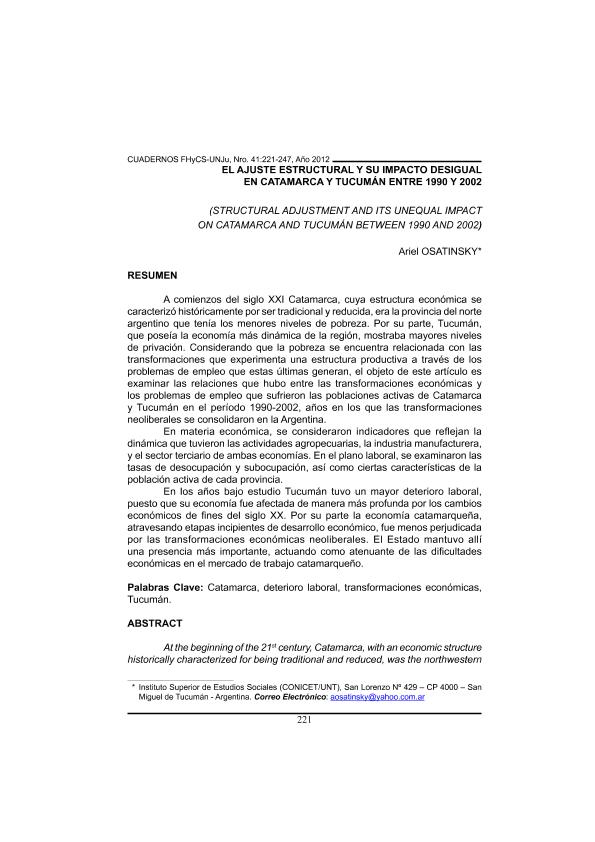Mostrar el registro sencillo del ítem
dc.contributor.author
Osatinsky, Ariel

dc.date.available
2018-12-26T17:56:54Z
dc.date.issued
2012-06
dc.identifier.citation
Osatinsky, Ariel; El ajuste estructural y su impacto desigual en Catamarca y Tucumán entre: 1990 Y 2002; Universidad Nacional de Jujuy. Facultad de Humanidades y Ciencias Sociales; Cuadernos de la Facultad de Humanidades y Ciencias Sociales; 41; 6-2012; 221-247
dc.identifier.issn
0327-1471
dc.identifier.uri
http://hdl.handle.net/11336/66974
dc.description.abstract
A comienzos del siglo XXI Catamarca, cuya estructura económica se caracterizó históricamente por ser tradicional y reducida, era la provincia del norte argentino que tenía los menores niveles de pobreza. Por su parte, Tucumán, que poseía la economía más dinámica de la región, mostraba mayores niveles de privación. Considerando que la pobreza se encuentra relacionada con las transformaciones que experimenta una estructura productiva a través de los problemas de empleo que estas últimas generan, el objeto de este artículo es examinar las relaciones que hubo entre las transformaciones económicas y los problemas de empleo que sufrieron las poblaciones activas de Catamarca y Tucumán en el período 1990-2002, años en los que las transformaciones neoliberales se consolidaron en la Argentina. En materia económica, se consideraron indicadores que reflejan la dinámica que tuvieron las actividades agropecuarias, la industria manufacturera, y el sector terciario de ambas economías. En el plano laboral, se examinaron las tasas de desocupación y subocupación, así como ciertas características de la población activa de cada provincia. En los años bajo estudio Tucumán tuvo un mayor deterioro laboral, puesto que su economía fue afectada de manera más profunda por los cambios económicos de fines del siglo XX. Por su parte la economía catamarqueña, atravesando etapas incipientes de desarrollo económico, fue menos perjudicada por las transformaciones económicas neoliberales. El Estado mantuvo allí una presencia más importante, actuando como atenuante de las dificultades económicas en el mercado de trabajo catamarqueño.
dc.description.abstract
At the beginning of the 21st century, Catamarca, with an economic structure historically characterized for being traditional and reduced, was the northwestern province of Argentina with the lowest levels of poverty. On the other hand, Tucumán, with the most dynamic economy in the region, showed even higher levels of privation. Considering that poverty is related to the transformations that a productive structure experiences by means of the employment problems that the latter create, the goal of this article is to examine the relations between economic transformations and employment problems suffered by the active populations of Catamarca and Tucumán in the 1990-2002 period , the years of consolidation of neoliberal transformations in Argentina. Regarding economic indicators, it was considered parameters that reflect the dynamic of agricultural activities, the manufacturing industry and the third sector in both economies. Regarding employment, unemployment and underemployment rates were examined, and certain features of the active population of each province as well. In the years under study, Tucumán suffered a higher deterioration in its labor market due to the fact that its economy was more deeply affected by the economic changes that characterized the end of the 20thCentury. On the other hand, the economy of Catamarca, going through incipient periods of economic development, was less harmed by the neoliberal economic transformations. The State kept there a more important presence, acting as mitigating factor for the problems in the local labor market.
dc.format
application/pdf
dc.language.iso
spa
dc.publisher
Universidad Nacional de Jujuy. Facultad de Humanidades y Ciencias Sociales

dc.rights
info:eu-repo/semantics/openAccess
dc.rights.uri
https://creativecommons.org/licenses/by-nc-sa/2.5/ar/
dc.subject
Deterioro Laboral
dc.subject
Transformaciones Económicas
dc.subject
Catamarca
dc.subject
Tucumán
dc.subject.classification
Ciencias Medioambientales

dc.subject.classification
Geografía Económica y Social

dc.subject.classification
CIENCIAS SOCIALES

dc.title
El ajuste estructural y su impacto desigual en Catamarca y Tucumán entre: 1990 Y 2002
dc.title
Structural adjustment and its unequal impact on Catamarca and Tucumán between 1990 and 2002
dc.type
info:eu-repo/semantics/article
dc.type
info:ar-repo/semantics/artículo
dc.type
info:eu-repo/semantics/publishedVersion
dc.date.updated
2018-11-05T19:16:30Z
dc.identifier.eissn
1668-8104
dc.journal.number
41
dc.journal.pagination
221-247
dc.journal.pais
Argentina

dc.journal.ciudad
San Salvador de Jujuy
dc.description.fil
Fil: Osatinsky, Ariel. Consejo Nacional de Investigaciones Científicas y Técnicas. Centro Científico Tecnológico Conicet - Tucumán. Instituto Superior de Estudios Sociales. Universidad Nacional de Tucumán. Instituto Superior de Estudios Sociales; Argentina
dc.journal.title
Cuadernos de la Facultad de Humanidades y Ciencias Sociales

dc.relation.alternativeid
info:eu-repo/semantics/altIdentifier/url/http://ref.scielo.org/hch8xg
dc.relation.alternativeid
info:eu-repo/semantics/altIdentifier/url/http://revista.fhycs.unju.edu.ar/revistacuadernos/index.php/cuadernos/article/view/178
Archivos asociados
